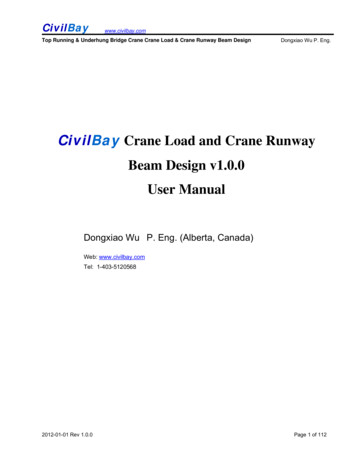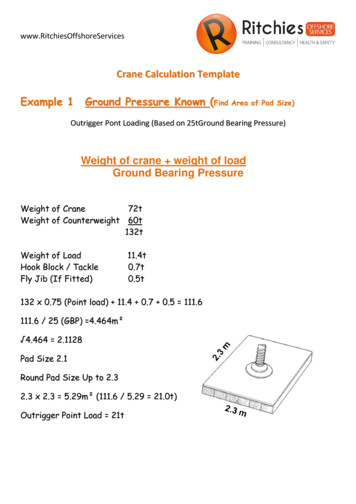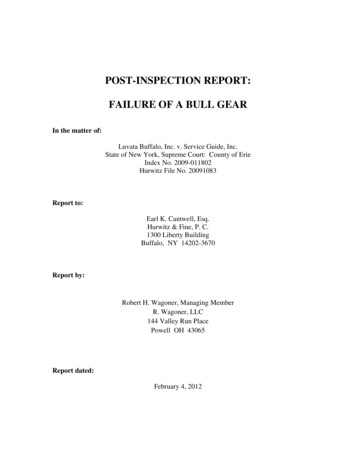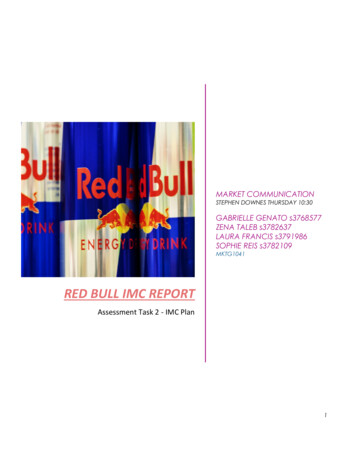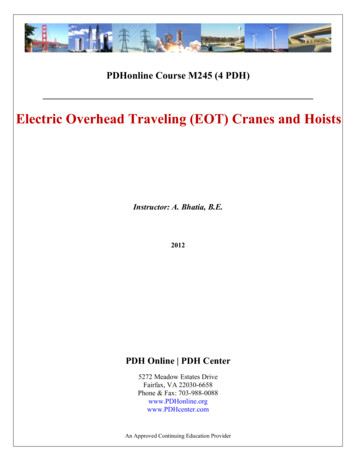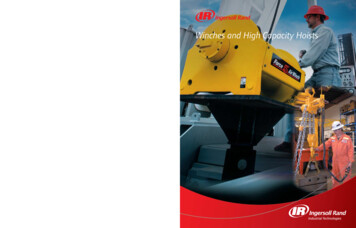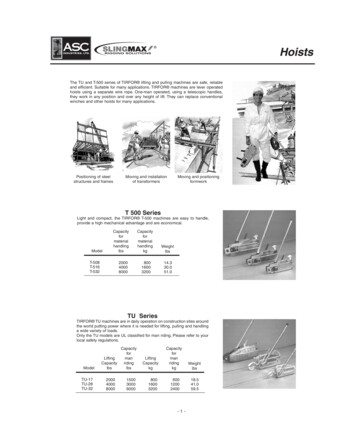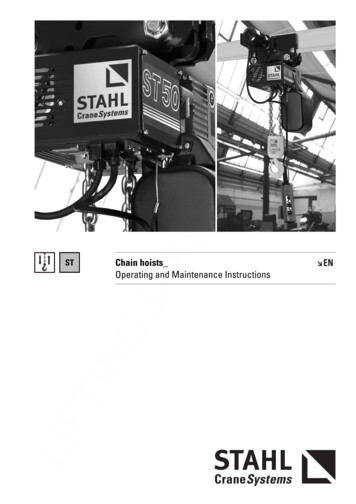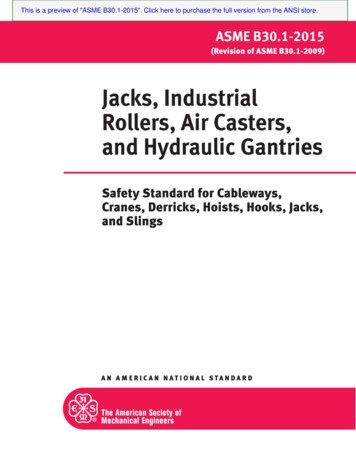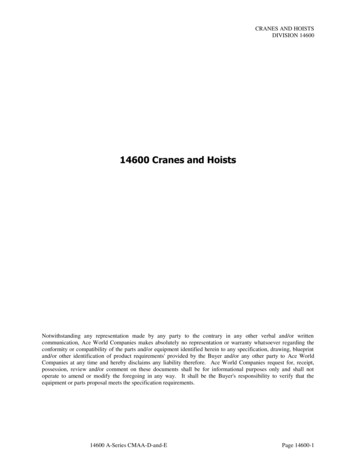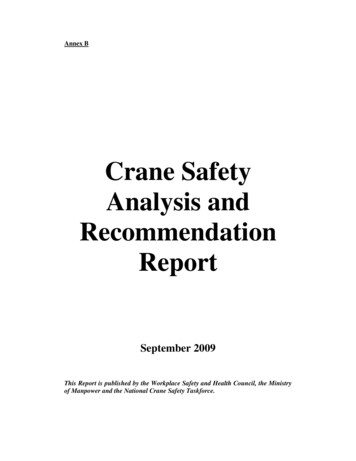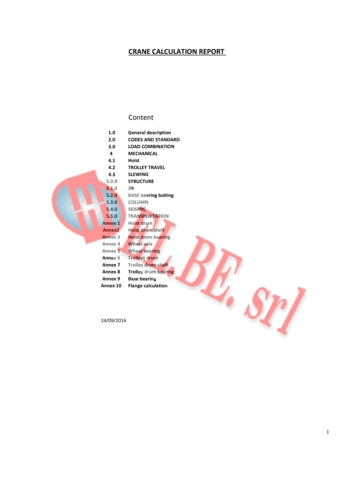
Transcription
CRANE CALCULATION .05.4.05.5.0Annex 1Annex2Annex 3Annex 4Annex 5Annex 6Annex 7Annex 8Annex 9Annex 10General descriptionCODES AND STANDARDLOAD COMBINATIONMECHANICALHoistTROLLEY TRAVELSLEWINGSTRUCTUREJibBASE bearing boltingCOLUMNSEISMICTRANSPORTATIONHoist drumHoist drum shaftHoist drum bearingWheel axleWheel bearingTrolleyt drumTrolley drum shaftTrolley drum bearingBase bearingFlange calculation24/09/20161
1.0General descriptionThe lifting appliance considered in this calculation report is a jib crane designed to liftvarious material in off-shore condition.This crane is foreseen for ARABIYAH HASBAH DEVELOPMENT PROJECT.The crane is composed by a column, fixed to the platform deck witha slewing double girder boom of fixed lengh on wich travel a trolley.The net capacity of the crane at the hook is 15 t.The mouvements of the jib crane hook are the classics : hoisting, trolley travel , slewing.HoistingRealized with a winch fixed to the strucure at one end of the boom , rope deviation sheaves ontrolley and return sheave on the other end ( outreach) of the boom and hook block.Cross travel: realized by means of four idle wheels at the corners of the trolley with :N. 1 trolley translation winch located at one end of the boomN. 1 return sheave at the other end of the boomSlewing: realized with base bearing that is the connection element between column and boomand two motor-reductors with pinion engaged on the bearing crown.2.0CODES AND STANDARDThe supply and the design have to comply with the technical specification of theSAUDI ARABIAN OIL COMPANY:JIB CRANE - Tag No.G63-U-130And for the calculation the followjngs code and standard will be adopted::API 2CF.E.M. 1.001 3rd edition(UNI7670)3.0LOAD COMBINATIONAccording to API 2C we take the following combination that is the haviest one because allthe forces and factors are taken into account as:Pay load 15,0 tdynamic factor Cv 2off-lead angle 0,50 side-lead angle 0,50 operational wind 75,6 Km/htangent acceler 0,2m/s2centrip. acceler. 0,03m/s2(negligible)3.1CRANE SCHEMEZtrolleybase bearingYcolumpedestal adaptorP2JibXP1LOAD CODITION3.2The conditions of load that will be considered in the calculation are two:Trolley in position 1 at the extreme (outreach at 10m from slew centre) position of the boomIn this position we have the haviest condition for boom structure, base bearing, column and pedestal adaptorTrolley in postion 2 at the middle of the two suspension point of the boom girderIn this position we have to check the stresses of the boom girder were the trolley run.2
4MECHANICALIn the following we start to calculate the various mechanismes.4.1HoistThe force on the ropes "SWLH" is composed by the pay-load to lift "SWL" plus the hook block dead weight.SWLH 150KN 5KN 155 KNWhere:150 KN the load to lift ( net crane capacity)5 KN Hook block dead weight4.1.1ropeThe minimum braking load "BL" required according to API rules is:BL W*DF/N*Ers 366 KNWhere:N 2reeving( is 2 lines of rope where 1 line go on the drum).W SWLH 155 KNDF 2,25xCv 4,5Ers (KbN-1)/[KbSxNx(Kb-1)] 0,952Reeving system efficiencyKb 1,02for roller bearingS 3total number of sheaves in reeving systemThe rope adopted is φ 22 mm with BL 441 KN 366KN that means DF 5,5 4,5The sheave pitch diameter is 400 mm 22x18 396 mmThe drum pitch diameter is 550 mm 22x18 396 mmReeving/Hoist schemeElectric motorBrakesropeGear reductorfix point4.1.2SWLHDrumThe drum diameter adopted in function of the geometry isφD 550 mmThe calculation of the minimum thickness af the drum body, of the drum, shaft and its bearingare in annexes 1 ,2,3. This calculation is done with the UNI rules and not onlyfor resistance but to have a life of 25 years that in this case correspond to 12500 hours of work.4.1.3Electric motorThe selection of the motors has been done taking in account the hoistig speed of the load"SWLH " and the efficiency due to the reeveng and gearing.N required power SWLH x v /(61,2x0,983x0,94) Where:v hoisting speed 54,39 Kw19 m/minThe adopted motor has a power of 68 Kw 54,39 Kw3
4.1.4BrakeThe brake service adopted is a doble shoes drum brake with electohydrailic thrustor.The max torque of the mechanism is:Mt torque of the mechanism Nm/ω 68.000/188,4 361 NmWhere :Nm motor power 68 Kw 68.000 Wω motor angolar speed 188,4rad/sec(1780rpm)188,4The service brake adopted, has Mf braking moment 800 Nm 2,2 x Mt 1,5x Mt4.1.5Gear reductorThe reductor gear has been selected taking in account the max torque required.The max torque required on the low speed(output) shaft is:Mt SWLH/N x φD /ERS 22393 NmThe adopted one has a torque of 29500 Nm 22393 NmThe theoretical ratio between the in/out shafts isr The adopted ratio between the in/out shafts isr 4.280,980,6Type:RXP3-814TROLLEY TRAVELThis mechanism is realized by a rope that pull the trolley in the two direction.The motion is driven by a drum on wich the rope are winded on one side and un-winded on the other one.The drum is coupled with a motoreductor with brake and the rope is fixed to the trolley.The trolley run on four wheels over two beams that are the boom of the jib crane .4.2.1WheelThis element transmit the actions to the boom via the rails.The rails adopted are constitued of a steel plate 30x50mmb 50 mmThe verification of the correct diameter will be done with the Fem rules for the class M5.Two condition have to be verified: one for the average load and one for the max load.Trolley weightPc 700 KgWheel diameterD 200 mmAccording to Fem rules we have:Coefficient C1 1,04 depending from the rpm of the wheel ( V 10 m/min)Coefficient C2 0,8 depending from the classificationDepending from wheel materialp 5 Mpa 27,6 KNPaverage [ (SWLH Pc)x2 Pc] / 3/4Pmax (SWLH Pc)/4 40,5 KNThe allowable pressure are:Paveall bxDxpxc1xc2 41 KN Paverage 27,6 KNPmax all 1,4xbxDxp 69 KN Pmax 40,5 KNThe axle of the wheel and its bearing are verified on annex 4and annex 54
4.2.2Trolley schemebrakeelectric motorgear reductordrumTrolleyWheelropereturn pulley4.2.3RopeThe rope required traction is the actionenought to pull the trolley with the load (SWLH) underthe influence of friction, acceleration, wind and offlead angle.The component due to offlead: SWLH *sen( 0,5 )The force due to a wind of 20 m/sec 300*10The force due to the friction rail/wheel (SWLH Pc)*0,010The force due to acceleration of 0,1 m/sec2 0,15x(SWLH Pc)The total force result Ft 1352 N3000 N8550 N2430 N15332 NThe rope adopted is φ 10 mm with BL 90 KN 15,4KN that means DF 5,8The adopted sheave pitch diameter is 200 mm 18x10 180 mmThe adopted drum pitch diameter is d 220 mm 18x10 180 mmThe calculation of the minimum thickness af the drum body, of the drum, shaft and its bearingare in annexes 6 ,7,8. This calculation is done with the UNI rules .4.2.4Electric MotorThis motor have to be with a torque and than the force enought to react the total force witha power enought to work with the previous conditions .V trolley travel speed 15 m/min0,25 m/secn motor rot. speed 1800 r.p.m.188,40 rad/secMt torque required Ft x V / n 20,3 NmThe motor is 3,5 Kw at 1800 rpm ( 188 rad/sec) with a start torque of 1,5 times the rated oneMt start adopted motor torque 27,9 Nm 20 Nm4.2.54.2.6BrakeThe brake adopted is a disc brake with electomagnetic thrustor.The max torque of the mechanism is:Mt max of the mechanism is N/n 19 NmWhere :N motor power 3,5 Kw 3500 Wn angolar speed 183rad/sec ( 1750rpm)The brake adopted, has Mf braking moment 40Nm 2,1 x Mt 1,0x MtGear reductorThe reductor gear has been selected taking in account the Fem rules for a class M6.The max torque required on the low speed shaft of the reductors is:Mt Ft (pull force) x d/2 (drum radius) 1687 NmThe ratio speed of input / speed output shafts is r 82,896The adopted one has a nominal torque of 2196Nm with a life of 50.000 hours.Type: EX253MD r 85,95
4.3SLEWINGThis mechanism is realized by means of a base bearing with external crown. The base bearinghas been choise on the basis of the max moment due to the various load and the motion is drivenwith two motoreductor by pinions engaged with the crown.The calculation is carried out for the worst condition that is with trolley with full load at 10m,operational wind of 20 m/s, acceleration , side-led angle and bearing efficiency.SWLH Trolley weigth Slew structure weigth swing circle Bearing friction factor swing speed ramp time angolar acceleration max SWLH radius polar inertia SWLH inertia dead weight 15500 Kg943 Kg22500 Kg0,9 m0,0060,5rpm6s0,009 rad/s10,0 m1644300 Kgm2104006 Kgm22,15 mThe moment required to swing is the sum of the following actions:Moment due to the bearing friction Moment due to acceleration Moment due to service wind Moment due to side-lead The total moment required Mt 4.3.12063 Nm15249 Nm55672 Nm33144 Nm106128 NmElectric MotorThe power required during the start is:Nswing Mtx ω/(ca/cn)/η Were:ca/cn starting torque 1,5general efficiency h 0,83,70 KWThe motors are n.2 of 3,5 Kw at 1800 rpm ( 188 rad/sec) with a start torque of 1,5 times the rated one3,7 KWNswing 2x3,5Kw 7Kw 4.3.2BrakeThe brake adopted is a disc brake with electromagnetic thrustor.The max torque of the mechanism is:Mt max torque of the mechanism N/n 19 NmWhere :N motor power 3,5 Kw 3500 Wn angolar speed 188rad/sec ( 1800rpm)The brake adopted, has Mf braking moment 30 Nm 1,6 x Mt 1,5x Mt4.3.3Gear reductorsThe reductor gear has been selected taking in account the Fem rules for a class M6.The max torque required on the low speed shaft of each of the two reductors is:Mtr (Mt / 2 )*(zp/zc) 7939 Nmwhere:Zp pinion theet numb. 19Zc crown theet numb. 127The ratio between the input/output shafts isr 523,6The adopted one has a nominal torque of 8000Nm with a life of 50.000 hours.6
4.3.4Base bearingThe base bearing is a type with three range of roller and external crown of theet.The overturning moment taking in account the various factor is:Moment due to factored load (Cv 2) Moment due to accelerations Moment due to Wind direction x Total overturning factored momentVertical load factored ( Cv 2)3156 KNm30 KNm6 KNm3192 KNm1983,75512,0 KN The base earing adopted "191.25.1800.990.41.1502 " see load curve at annex 9 in this conditionwith the upmentioned vertical load allow the following moment:5.0.0Dynaminc allowable moment Mtdall 4200 KNmStatic 4800 KNmallowable moment Mtsall 3192 KNm3192 KNmSTRUCTUREThe calculation is carried out taking in account the forces of the mechanical actions andas told at the beginnig, in a conservative way ( See Annex 12 ).The material adopted for the structures is S355 J2 ( sometimes called also Fe 510D) that, accordingto API and others codes, being σy/σu 0,7 the allowable stress are:σ all τ all Jib5.1.1Jib Schemewith wind2270 N/mm2156 N/mm3P418455.1.2exceptional2300 N/mm2174 N/mm219455.1.0operational2240 N/mm2140 N/mm800011300PPOSITION 1Girder 1 Two IPE 400 coupledσ max 197N/mm2 σ all 240N/mm2τ max 53N/mm2 τ all 140N/mm2σ id 217N/mm2 σ all 240N/mm2The stresses are inclusive of all the actions and factors (Cv 2) and the allowable stress is bigger thanthe max permissible because the actions include also the wind but, to be more conservative, we takein account the stress allowable lower one.Tie rod 2This element is only tensioned and is built with a pipe φ 152 mm thikness 12 mmσ max 157N/mm2 σ all 240N/mm27
Tie rod 3This element is only tensioned and is built with a pipe φ 152 mm thikness 12 mmσ max 189N/mm2 σ all 240N/mm2Compressed item 4This element is only compressed and is built with a pipe φ 152 mm thikness 12 mmσ max 146N/mm25.1.3 σ all 240N/mm2POSITION 2With the pay load in the middle of the boom as shown we have the following stresses:329321951 P248410P11920σ max 210N/mm2 σ all 240N/mm2τ max 26N/mm2 τ all 140N/mm2σ id 215N/mm2 σ all 240N/mm2The stresses are inclusive of all the actions and factors( Cv 2) and the allowable stress is bigger thanthe max permissible because the actions include also the wind, but to be more conservative we takethe allowable lower one.Tie rod 2This element is only tensioned and is built with a pipe φ 152 mm thikness 12 mmGirder 1σ max 77N/mm2 σ all 240N/mm2Tie rod 3This element is only tensioned and is built with a pipe φ 152 mm thikness 12 mmσ max 92N/mm2 σ all 240N/mm2Compressed item 4This element is only compressed and is built with a pipe φ 152 mm thikness 12 mm5.2.0σ max 89N/mm2 σ all 240N/mm2BASE bearing boltingAccording to the API 2C rules,the ultimate strenght criteria of the bolts have to satisfied the following:P 4*M/Nb*D - H/Nb 552,0 KNwhere:P max allowable force in one boltM 3,75 x total overtur factored mom. 11970 KNmNb number of bolts 48D bolts circle diam. 1,685 mH 3,75xvertical factored force 1920,0 KNA resistance section of bolt M30 561mm2sbolt 984N/mm2sall 1000N/mm2 sboltSo we can say that the bolts class 10.9 is acceptable.Flange plate edge column calculation see annex 108
5.3.0COLUMNThe verification will be carried out for the section at the base were the column is welded to the deck.Dc column outer diameter 1800 mmth column thikness 20 mmJ x inertia moment 4427764cm4Wx resistent mom. 49197cm3Ac section area 111784mm2The actions on this element is the same of the base bearing increased by the moment of transportgenerated from the wind , acceleration and its the vertical dead load.Furthermore the API rules foreseen for the crane support structure an additional factor PF that appliesto the factored load.PH 1,56- SWLH/900000 1,56Were value of PH must be not less than 1,2 but not greater than 1,5 so in our case :PH 1,5The vertical factored action and moment included the additional factor PH result:Hc Mc 937 KN4788 KNmσ all 240N/mm2σ all 240N/mm2 σb max 97N/mm2σc max 8N/mm2τ
150 KN the load to lift ( net crane capacity) 5 KN Hook block dead weight. 4.1.1 rope. The minimum braking load "BL" required according to API rules is: BL W*DF/N*E. rs 366 KN. Where: N 2 . reeving( is 2 lines of rope where 1 line go on the drum). W SWLH 155 KN DF 2,25xCv 4,5 E. rs (K. b N-1)/[K. b S. xNx(K. b-1)] 0,952. Reeving system efficiency. K. b 1,02. for roller .
